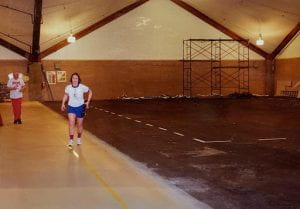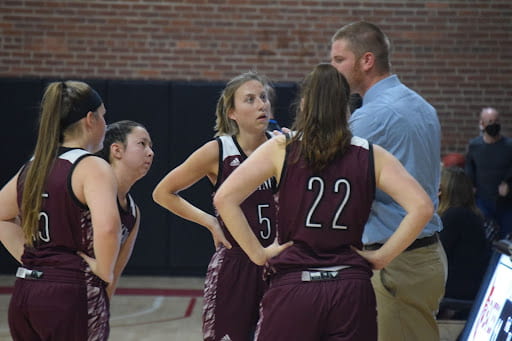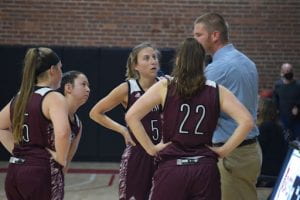Dec 16, 2021 | Exclusive, Feature, TopStory, Uncategorized |
By Emma Dipompo, Contributing writer
Hey guys! Bubbles again. It’s that time of the year again when all you college folks pack up and go away for a little while. I don’t want any of my buddies to get left behind this year, so I’ll give you guys all kinds of helpful information to get us both home safely.
I’ll make my vacation preparation really easy for you guys, I don’t want to stress you out. Before you start packing up your room it’s important to take care of me first. I’ll need to go on a bit of a diet before we start moving. I should fast for a day or two before we start traveling so that my travel container doesn’t get too dirty. I don’t think you’re going to pull over every time I need to use the little guppies’ room.
The next thing you’re gonna need is some kind of cup to put me in. Any food safe tupperware will work for me, even a well washed McDonalds cup can serve as a makeshift travel container in an emergency. It’s not stylish, but who’s college car is?
After getting a small container make sure to put nice clean tank water in it. I don’t want to be in that cup for more than a few days, so make sure I’m the last thing you pack up. Once I’m in my cup you have to keep me in safe, warm places. I wouldn’t want to be forgotten on a car roof, would you?
If you’re planning on flying home this year, have no fear for me and my fishy friends. We can tag along too. Most airlines allow you to take a fish on the plane as a carry-on as long as we’re in a clear container. The TSA website would like to remind anyone flying with a fish to tell the airline you are going to do so before showing up the day of the flight. Some airlines, like Southwest, don’t have a fish policy so it’s important to do your homework and make sure we can both get home safely.
Once home I’ll need a temporary tank, but this one doesn’t have to be too fancy. I can live for a little while in a good sized storage container, or a cheap 1 gallon fish tank until we get back to college. As long as I have more than 1 gallon of water, my filter and my heater I’ll get along swimmingly.
Traveling is always stressful, but let me be your emotional support fish for just a little while. Together we can, quite literally, cross the world. – The one and only. Bubbles.

Dec 16, 2021 | Exclusive, Feature, News, Sports, TopStory |
By Michael Levesque, assistant editor and staff writer
This spring marks the 30th anniversary since the Fitness and Recreation Center (FRC) opened its doors to UMF and the community.
Since the building’s first official day on April 27, 1991, a lot has changed. Among these changes are the students and community members who use it, the staff who keep the building functioning, and the equipment inside. Noticeably missing from that list is the building itself. The Fitness and Recreation Center today greatly resembles the building that was made almost 30 years ago. “This office here used to have lockers where the group fitness instructors would change but it also had the director, the assistant director and the administrative assistant,” says Linda Blodgett as she gestures around the room her office is in. Blodgett has been working at the university since 1989. In 2001 she moved from the business office, where she started, to the FRC. “I was in the business office, it didn’t look like it does now,” said Blodgett. “Coming down here was much more comfortable for me – I haven’t regretted it. I have been on this campus for 32 years and I just love working down here.”
The familiar sight of the FRC has created an intimate atmosphere that many students and community members have come to value. “What I love the most is the sense of team camaraderie,” said Danny Terhune, a student and Physical Education instructor at the FRC. “[I love] the staff as a whole, you truly feel seen.”
“We’re such a unique facility, where the community comes in here and it’s really kind of neat,” Blodgett added. “Our staff that works here gets to know the community members and they see them outside of this place and our community members are always greeting them. It makes the students feel at home. It’s really really nice.”
Since the building’s erection in 1991, the building has adapted to the fitness and recreation needs of the community members. One year after the building was first opened to the public, the pool was installed. “Fitness is always evolving,” says Blodgett. “Body building was big back then. Group fitness was [also] really popular. Now it’s evolving into strength training.”
In order to meet the ever changing needs of the members of the community, constant work and refinement is done to the equipment within the FRC – with a cost as well. “There’s a lot of challenges,”says Blodgett, “the price of equipment is going up…[as well as] the maintenance of it. The cost of maintaining this equipment is a lot. There’s not a lot of companies around here that maintain equipment.” The COVID-19 pandemic has also contributed to the challenges at the FRC. “Trying to keep our membership up [is a challenge]. Our outside members, not just the students… are huge,” Blodgett says.
Even as the challenges continue, many in the community still treasure the building and the community with it. “I hope this place stays here forever,” says Blodgett. “I just hope that UMF… realizes how much this facility means to the people – students and community members… I hope it stays for the next 30 years because it is a great facility and it’s great for our students… You know, our students that work here learn so much about dealing with the public, it gets their confidence up. A lot of our graduates that work here say they haven’t found a facility they like more than here.”
“I love how I get to share my love of fitness with these coworkers as well as students in my class,” Terhune says. “This helps me as an education major really practice my skills as a teacher outside of my normal classes.”
Ben White, Director of Fitness and Recreation at the FRC, was pleased to announce some of the celebrations for the 30th anniversary coming in the spring. “A canoe race, mountain bike race, and 5k run” are all scheduled for the spring, according to White. As of right now these activities are scheduled for April 30th, 2022 – three days after the official 30th anniversary day. A reception will also be held later than afternoon. “The hope is that we get as many alumni back that we can that have worked here or that have gone to school here. I know a lot of alumni that went to school here that have never stepped foot in the building,” Blodgett says.
More details about the celebration in April are expected to be released on the FRC Instagram and Facebook pages as well as through their newsletter. The front desk at the FRC can be contacted at (207)-778-7495.

Community members inside the FRC prior to the completion of a basketball court. Photo courtesy of Linda Blodgett.



Construction on the Fitness and Recreation Center building. Photo courtesy of Linda Blodgett.

Dec 16, 2021 | Exclusive, Feature, News, Sports, TopStory |
By Page Brown, contributing writer

Nathan Carson speaks to his players during a free throw against Bates College on Nov. 16. Courtesy of Jacqui Hamilton.
UMF’s women’s basketball team is off to a strong start under the guidance of newly hired interim basketball head coach Nathan Carson. The squad, who is sitting at 5-2, saw key wins including winning the Castleton Invitational Tip-Off Tournament and the UMF Tip-Off Tournament in their opening two weekends of play.
Carson came into the program familiar with the players and program as he served as an assistant coach for the men’s program since the 2014-2015 season. Carson himself is a UMF graduate, graduating in 2014 with a degree in community health and playing for legendary UMF coach Dick Meader. While playing for the Beavers, Carson saw immense success, starting for three years and scoring 536 points, while maintaining a 77.6% free throw percentage and 36.5% three-point field goal shooting percentage. During his senior season, the team reached the North Atlantic Conference Men’s Basketball Championship.
The new coach hopes to bring his success to the team as the squad looks for a deep tournament run.
“The team is off to a strong start, we have had some gritty wins in the first half of our season. We love to get out and run and have fun, and I know that when we do that, we can be a dangerous team in NAC play.”
The desire to reach the playoffs comes to no surprise as the team returns 13 players, including all five starters from the 2019-2020 season that saw the team reach the championship game. The veteran led group is headed by a large senior class, thanks in part to the pandemic granting two players an additional year of eligibility within the National Collegiate Athletic Association.
Since the 2019-2020 season, the team has lost only four players: 2020 graduate Sara Lamb, 2021 graduates Halee Ramsdell, Kasey Talerico, and Chelsea Crockett. UMF forward McKenna Brodeur, a two-time first team all-star, looks to lead this year’s squad to a North Atlantic Conference Championship. She is joined by senior guard Alex Bessey, a second-team all star, and senior guards Makayla Wilson, Tia Day and senior forward Page Brown. Other key returning players for the Beavers this year include senior guard/forward Molly Folsom, junior guard Courtney Brent, and senior forward Cassidy Delano.
Yet the experienced group is also joined by a group of new players and coaches. Six players, Emily Small, Maddie Forgues, Kiely Renyolds, Jalyn Stacy, Jaycie Stevens, and Grace Woodman join the team. The group looks to make an immediate impact on the team, highlighting the talent on this years’ squad.
The squad was able to compete in only two scrimmages in the 2020-2021 season. However the 2019-2020 year saw the team going 14-14, culminating into a huge 70-63 win against conference foe Maine Maritime Academy in the NAC semi-final before falling to five time champion Husson University 70-60.
Dec 16, 2021 | Exclusive, Feature, Opinion, TopStory |
By Reese Remington, contributing writer
Farmington, ME – In a country where the Kyle Rittenhouse’s run free, Black people march for their lives, and a new culture is emerging where America’s inequalities are finally being highlighted for what they are, there lies a small campus amongst it all – the University of Maine at Farmington.
What does a small school like UMF have anything to do with this? Seemingly nothing, and yet everything. Like every university in America, it is a small piece of a much larger pie.
Similar to other minorities on campus, the beginning of the year looked different for me compared to my white peers. Yes, the first-day jitters are the same, followed by a silent prayer that I have a great semester. That my professors understand me, and I make some friends. However, I understood the risks that come with attending a Predominantly White Institution (PWI). This means also hoping that there are other like-minded minorities on campus, nothing racist happens towards me, and make peace with the microaggressions that will inevitably happen.
On campus, everywhere you turn there’s some kind of incident happening against minority students. Though I suppose we should be grateful that there isn’t any ‘KKK’ type of racism taking place here, the microaggressions and tone-deafness run rampant. In my first week, I heard students saying the N-word in a song. Later on in the semester, I was accused of stealing; like other minorities on campus who have been accused of crimes that they didn’t commit. There have been too many microaggressions to count – from comments about my hair, the way I present myself, down to interactions with other students. I have simultaneously been used as the Black spokesperson in my class while also being encouraged to use ’empathy’ and ‘compassion’ when responding to racist discussion posts. On campus, you either love or hate that I am ‘opinionated’ and always have something to say. But if Black people don’t speak up against racism, who will? My classmates, professors, and community members have shown that they won’t. Unless of course, it’s in the form of an Instagram story so everyone knows that they aren’t racist – outwardly at least.
This isn’t to say that UMF isn’t inclusive. It is – to an extent. UMF prides itself on being a strong LGBTQ+ friendly campus, striving to include everyone on campus. Though the tone-deafness outshines the efforts being made. UMF refers to their LGBTQ+ students as the minorities and diversity on campus. To be frank, when the campus is predominantly LGBTQ+, it is no longer a minority. The minorities on campus are the Black and POC students.
If you look around you, the tone-deafness is everywhere – though only if you want to see it. It’s in the buildings where they put posters of how “we appreciate our UMF students and the DIVERSITY they bring to campus” in all rainbow lettering for the LGBTQ+ community. They use the Black power fists for club posters without a single Black member in the club. It’s in the way they handle racist incidents privately and put other incidents [with white students] in a campus email. Don’t minority students deserve to know what’s going on around campus? And it’s especially in the way the school handled the ‘Ed situation’, yet lacks that same passion when it comes to the real minorities on campus.
However, times are changing. It’s been a year and a half since the BLM marches took place and we as a community decided it was time to rise and do better. For ourselves, and our underrepresented minorities in our community. UMF now has a Black Student Union for the first time in history. While other clubs have been up and running for years, the BSU has just begun. Even when established, it wasn’t without questioning whether white students could join and what would happen if there was racism in the club. Anything minority students have done or created on campus has been met with resistance, but this doesn’t stop us. Minority students are creating a more inclusive and safer community for future minorities on this campus.
So, where do we as a school go from here? First, you show up. Show up for your minority peers by calling out racism and microaggressions on campus – beyond posting a simple Instagram story. Forgive me for not expressing gratitude to those that do the bare minimum. As minorities strive to change the racist culture that still runs strong in America, we no longer accept the low-level work that is being done to ease any white guilt. Or at least I won’t. I would say most importantly, show up by educating yourself; Black people are not your Black encyclopedia, every Black experience on this campus is unique. We are not all the same.
Second, advocate. Advocate for more classes that properly teach the history of minorities in America. Advocate for Black and POC voices on campus. We need more minorities in leadership roles. From professors and within the administration, down to leadership roles in the clubs, sports, and elected positions among the campus. The representation we have on campus now – is only a start and not nearly enough. We cannot advertise ourselves as an inclusive school for minorities and then miss the mark when it comes to being inclusive.
Lastly, realize that this change doesn’t happen with just the minorities on campus pushing for it. This isn’t a quick fix situation, it takes time to break down a system that then needs to be rebuilt so that real change can occur. It may not happen overnight, but as a campus, we can do better. Know when to speak up for your classmates, and when to sit back and listen to them. Understand that in striving to be an inclusive campus, UMF has left a part of their own in the shadows: minorities on campus.
Dec 16, 2021 | Exclusive, Feature, News, TopStory |
By Jessica Gervais and Sophia Turgeon, Contributing writers
Most students that attend UMF are not aware that it is one of three schools in the UMaine system that have actual police departments as a part of their campus safety force. According to a 2019 survey released by the Association of American Universities (AAU), there is a 13% rate of nonconsensual sexual contact at colleges. This percentage is alarming.
Haley Sewell, sophomore at UMF, was at the Halloween dance hosted by the ACE club on 22 October with a large group when she witnessed an incident involving sexual misconduct. According to Sewell, she had been dancing with her group of friends in a circle when she noticed an individual had joined her group and began dancing inappropriately, touching other friends in the group. “Everything was fine at first, but then the student started getting out of hand,” Sewell said.
This incident went on for some time, even when Sewell was in smaller groups. The harasser would leave, but always return to make the girls uncomfortable. Moreover, they had made it obvious that no one was interested in the individual, but still, after all of this, the harassment persisted.
“We thought that he’d finally gotten the hint that he was making us uncomfortable, but he came back a little while later,” Sewell stated. “This time he was more aggressive in his approach. He continued to dance towards one of my friends, and this time reached out to grab her hips.”
Once this was happening, Sewell began looking out for her group of friends to make sure they were comfortable, even at times pulling girls away from him. “At one point we stopped for a water and bathroom break, where we heard from at least six other girls that the same student was humping, grinding, and groping girls. One girl even told us that her guy friend had to get between her and the individual and tell him to back off,” Sewell said.
After hearing this, Sewell and her friends decided to tell a chaperone, who was also an officer, exactly what had been happening during the dance. However, once the student was pointed out to the officer, he tried to weave through groups of students as an attempt to get away. Instead of being chased down though, the campus officer informed Sewell and her friends that he was going to back off and not engage. This decision angered the group. Why would one of our own campus officers simply back off and not stop this harassment immediately, they wondered.
After returning to her group of friends, Sewell said the harasser continued to follow her group around throughout the night, even at times targeting her directly. As the night progressed, the group lost contact with each other at times but finally joined back together to leave.
“After we left, we didn’t hear anything about what happened for about a month,” Sewell said.
According to Sergeant Wayne Drake, the department handled the situation correctly. In discussion, Drake said that he had followed the harasser and it was simply “poor bedside manner on the police department’s end.
In an interview with Brock Caton, the Director of Public Safety at UMF and the Police Chief for Farmington, Caton explained that in order for someone to be charged with anything, including sexual assault, there has to be “probable cause”.
“Probable cause” usually includes all elements of the crime in question. If there is “probable cause” present, then there are different ways that various crimes concerning sexual assualt are handled. This matter can sometimes include issuing a criminal summons forcing the person to appear in court and/or be arrested. Upon arrest, they’re transported to the Franklin County Jail to be booked. Once the booking process goes through, the case moves onto bail conditions along with other court proceedings later on. If the case goes as far as trial, the involved parties may be called to court to testify. Although most people bring along someone for support, the system prefers that interviews be done alone. The case being if they bring someone, especially another student along, the other person becomes a witness automatically in the investigation. This means they may be asked to testify in court. However, if the individual doesn’t feel comfortable being interviewed alone, the system will try to arrange the involvement of a Victim Advocate to be present and serve as support.
“… they (a Victim Advocate) will guide the complainant through the criminal justice process, to include assisting them with receiving resources and obtaining a Protection Order, if need be”, said Caton.
Thus, it can be extremely beneficial to have someone from Victim Advocate present for support if desired. If the complainant doesn’t wish for a person from Victim Advocate to be present, there is also the option of an informational brochure that is optionally provided. The brochure additionally provides information for the Victim Advocates just in case. All other witnesses will be interviewed alone in order to get the accurate and independent story version of what occurred in the incident.
For more information about the University of Maine Farmington’s safety department/Campus Police, go to https://www.umf.maine.edu/campus-life/campus-safety/
Dec 16, 2021 | Exclusive, Feature, News, TopStory |
Reese Remington
There’s a new club on campus making history with its formation. The Black Student Union (BSU) aims to create space for Black students- something that UMF hasn’t had before.
The BSU was founded by Junior Aman Hagos, who led three different BLM protests in Farmington last year. Hagos saw the need for a space for minority students to feel safe and seen.
This year’s freshman class is more diverse than ever before, and several Black students have confirmed Hagos’ feelings of a lack of space for Black students. Two freshmen on campus are excited to be a part of the change: Suki Fuzzell and Klaus Jacobs, originally from New York and Maryland respectively, came to UMF for the outdoors and a change of scenery from the city life. However, it hasn’t been a smooth transition.
Fuzzell recalls her time on campus as a minority as just okay. “I’ve had a couple of microaggressions here and there, but there’s nothing to do about it so you just keep going,” Fuzzell said. “However, I did drop my history class because it was kind of weird to be the only Black person in there and have them talk about slavery while being stared at so I dropped it for my own comfort.”
Jacobs shared a similar stance with their experience. “It’s been okay. Because I’m not as outgoing as other people it’s hard to make friends,” Jacobs said. “With white people sometimes they’re really close-knit – and that’s not a bad thing, but it’s hard to insert yourself into a close group. There have been people though who are understanding and can see that it’s hard being a Black woman on campus. It was a shaky start but overall good.”
Among other minority students on campus, the biggest issue Jacobs and Fuzzell have noticed at UMF is the lack of thoroughness and assertiveness towards racist events that take place. When asked if they believed UMF was inclusive, there was hesitation.
“I don’t think Farmington isn’t not inclusive but I think they could be a lot more inclusive,” said Fuzzell. “A lot of the issues that have happened with minority students have been brushed under the rug but if it’s a white student, it’s out in an email and everyone knows about it. It’s hard to not notice those types of things when there have been serious issues that aren’t being talked about.”
Jacobs and Fuzzell both agreed that Black students have a right to know what’s happening on campus, especially in regards to race.
“When you’re literally outnumbered by everyone on campus, your safety – it should be a top priority and sometimes it isn’t so you never really know what’s going on because you can’t prepare yourself for what’s going on if you don’t know,” Fuzzell said.
Despite the shaky start of the semester, Fuzzell and Jacobs both hope to see a difference by the time they are seniors, starting with the BSU.
“Honestly, I just want there to be more diversity by the time I’m a senior. I hope to see more cultural clubs that teach and celebrate different cultures – not just for us but for other students to learn about things that they might not really know because they aren’t taught about it here,” Fuzzell said.
Fuzzell also hopes to see more friends come out of the club. “When I came here, I was a little intimidated to go up to other Black students because they have been here longer than I have but having a club like this will open up that door and make it easier to find friends on campus that are other Black people instead of kind of feeling singled out,” she said.
Jacobs hopes for the same type of experience from a BSU on campus. “With a Black Student Union, it would be like having a little community – sometimes I need something for my hair or a product and I can’t ask my roommate or most of my friends so it’s little stuff like that, that matters.”
The Senate voted Monday, Nov. 1st, 2021 to make the BSU an official club on campus.






